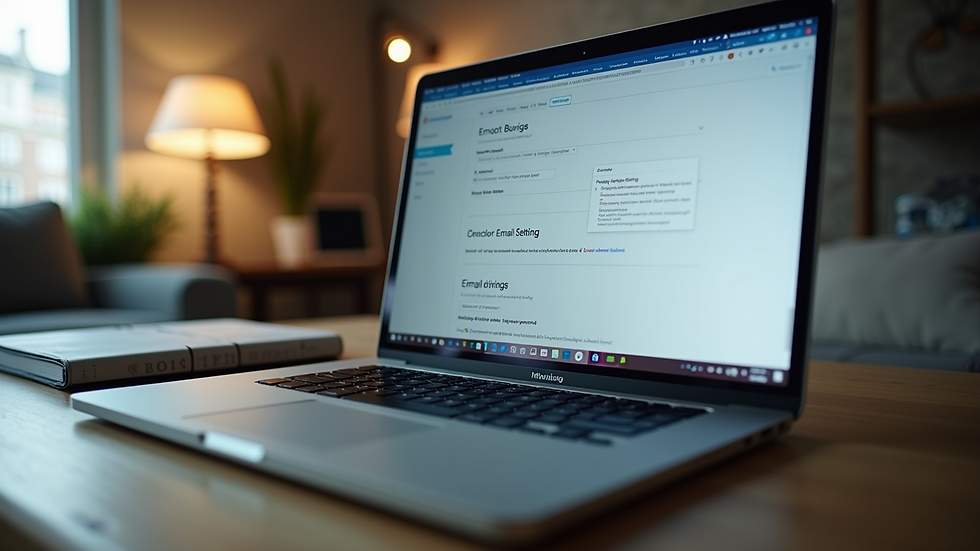Effective Inbox Management: How to Organize and Filter Your Various Inboxes
- Sarah
- Jun 18
- 5 min read
Managing several inboxes can feel overwhelming. Whether it's personal correspondence or professional communications, the volume of information can lead to stress and hinder productivity. This blog post will explore effective techniques for organizing and filtering your various inboxes. By adopting these strategies, you can streamline your communication and take back control of your time.
Understanding the Importance of Inbox Management
Proper inbox management is not merely about keeping your emails tidy; it is about enhancing your overall efficiency. Studies show that an organized inbox can save you up to 30 minutes each day. That’s a significant amount of time when accumulated over weeks and months. By filtering and organizing your emails, you can focus on the messages that truly matter and respond promptly without getting lost in a sea of unread messages.
To achieve effective inbox management, you must start with a clear understanding of your priorities and the tools at your disposal. Whether you’re using Gmail, Outlook, or another email service, the techniques outlined here can be adapted to any platform.

Analyze Your Email Habits
Before you make any changes, take a moment to analyze your email habits. Here are some questions to consider:
How often do you check your email?
What types of emails do you receive most frequently?
Do you respond to emails immediately or let them sit?
Are there newsletters or promotions that regularly clutter your inbox?
Understanding your behavior can help you identify areas for improvement. For example, if you find that you receive numerous promotional emails, it may be time to unsubscribe from some of those mailing lists. Tools like Unsubscribe can help automate this process.

Create Specific Folders or Labels
One of the most effective ways to manage your inbox is by creating specific folders or labels. This is especially useful if you handle various types of emails, such as work, personal, subscriptions, and important communications. Organizing your emails into designated categories can significantly enhance your ability to locate specific messages quickly.
Steps to Create Folders or Labels:
Identify Categories: Start by listing out the types of emails you receive most frequently. Common categories include “Work,” “Personal,” “Subscriptions,” and “Follow-ups.”
Create Folders: Within your email platform, create folders for each category. You can usually do this through your settings or by right-clicking on your inbox.
Utilize Labels (if applicable): Some platforms, like Gmail, enable you to apply labels to emails without moving them out of the inbox. This lets you tag emails with multiple categories for better organization.
Consistent Maintenance: Regularly review and update your folders to ensure they remain relevant as your communication needs change.
Automate Your Inbox with Filters
Manual sorting can be time-consuming, which is why utilizing filters is paramount in email management. Most email platforms offer filtering options that automatically organize your messages based on the criteria you set.
How to Set Up Filters:
Access Settings: Go into your email settings and look for the "Filters" or "Rules" section.
Create a New Filter: Specify the criteria for the filter, such as sender, subject line, or keywords. For instance, you could create a filter for all emails from your boss to go directly into a “Work” folder.
Choose Actions: Determine what action the filter should take, such as moving the email to a folder, marking it as important, or even deleting it outright.
Test and Adjust: Monitor how the filters perform and make adjustments as needed, based on your evolving needs.

Prioritize Your Emails
Not all emails require immediate attention. By prioritizing your emails effectively, you can take control of your time and ensure that you address urgent matters first. The Eisenhower Matrix is a handy tool for prioritization. This approach involves categorizing tasks based on urgency and importance:
Important and Urgent: Respond immediately
Important but Not Urgent: Schedule a time to respond
Urgent but Not Important: Delegate if possible
Neither Urgent nor Important: Consider deleting or archiving
As you go through your emails, apply this matrix to decide which messages deserve your immediate attention and which can wait.
Set Clear Boundaries for Email Usage
While emails are integral to communication, establishing boundaries can significantly improve your productivity and mental health. One effective method is to designate specific times during the day for checking and responding to emails, rather than allowing them to interrupt your workflow.
Tips for Setting Boundaries:
Schedule Email Time: Pick specific times in the day when you’ll focus solely on emails. Limit these to a few short sessions, such as 15-30 minutes.
Turn Off Notifications: Disable email notifications outside of these designated times to minimize distractions.
Communicate Your Availability: Inform colleagues or contacts of your email schedule, so they know when to expect a response.
Creating these boundaries not only helps manage your inbox but also fosters a healthier work-life balance.
Regularly Clean Up Your Inbox
An important aspect of inbox management is maintaining a clean inbox over time. Regular clean-ups prevent clutter from building up and help you stay organized.
Suggested Clean-Up Schedule:
Daily: Spend 5-10 minutes each day deleting unnecessary emails and managing subscriptions.
Weekly: Dedicate time each week to organize folders and labels, review unread messages, and respond to important emails.
Monthly: At the end of each month, conduct a thorough review of your inbox. Archive old emails and reassess your folders and labels for relevance.
Keeping a clean inbox requires commitment but will yield significant benefits in the long run.
Embrace the Benefits of Digital Tools
Finally, consider leveraging digital tools designed to enhance email management. Various applications and extensions can help you efficiently manage your emails.
Some Popular Tools Include:
SaneBox: Automatically sorts your emails into manageable categories and helps you declutter.
Boomerang: Allows you to schedule emails for later, set reminders, and even track responses.
Unroll.me: Quickly unsubscribe from unwanted newsletters and promotions while consolidating your remaining subscriptions into a digest.
Using these tools not only saves you time but also helps reduce the stress associated with an overloaded inbox.
Take Action for a Manageable Inbox
By implementing these strategies for inbox management, you can effectively organize and filter your various inboxes. Not only will this improve your productivity and focus, but it will also enhance your overall digital communication experience. Remember that finding the right approach may take time and require adjustments, but the benefits are worth the effort.
Transitioning to an organized inbox is not an overnight task, but by dedicating a small amount of time each day to the process, it will eventually become a natural part of your routine. Happy organizing!




Comments